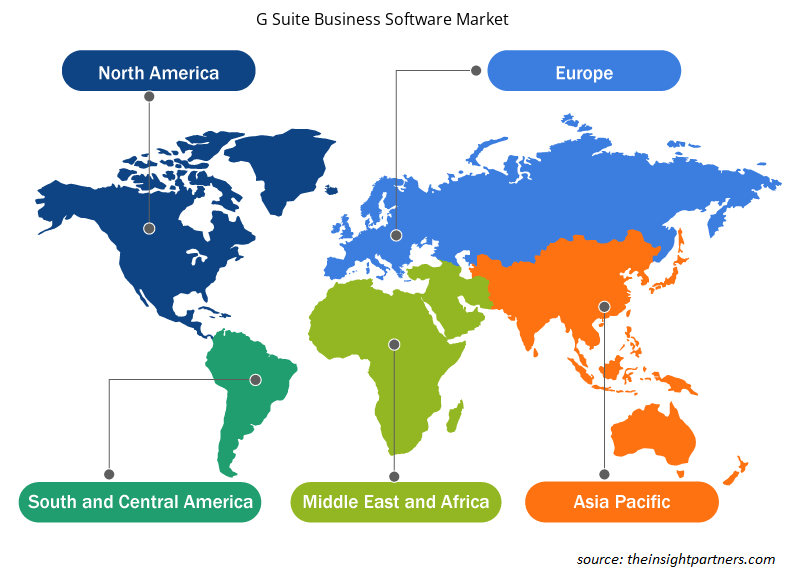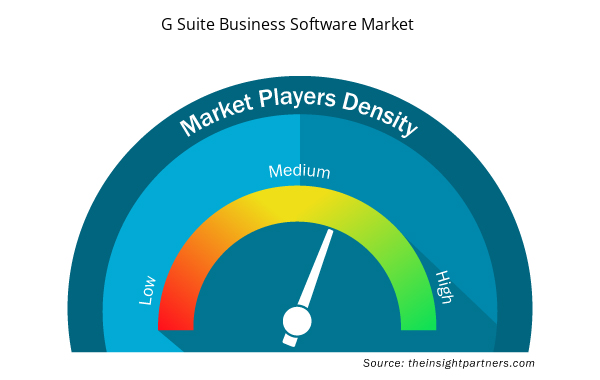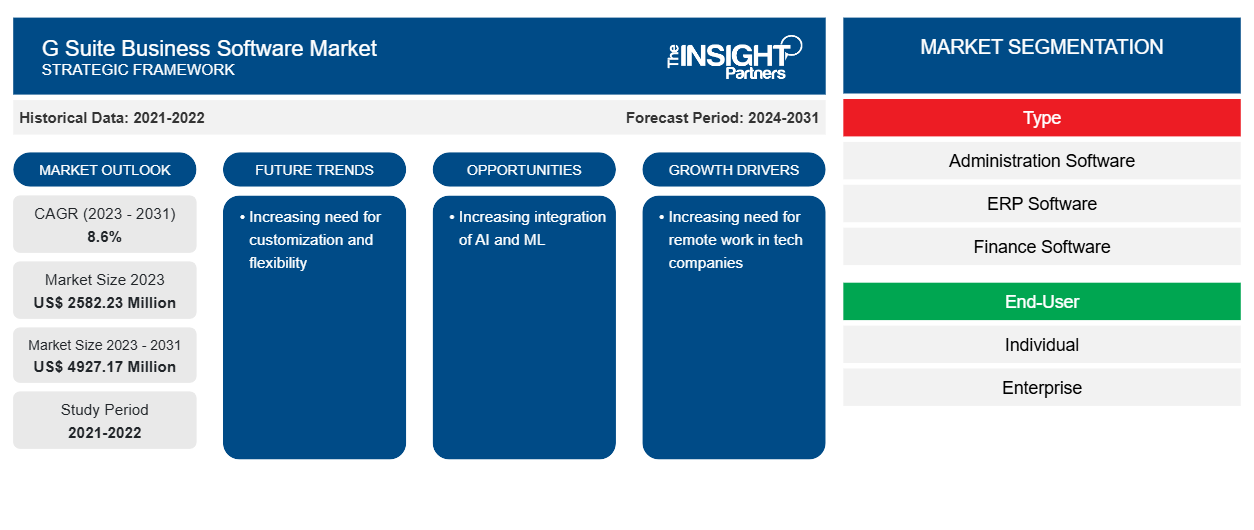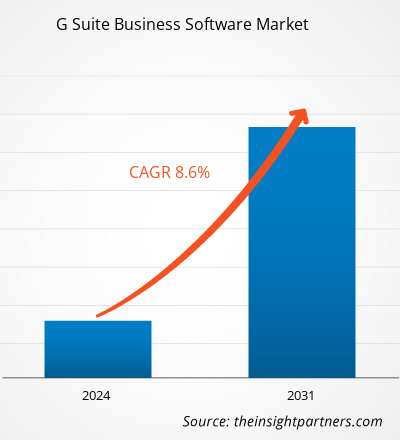Der Markt für G Suite-Geschäftssoftware soll von 2582,23 Millionen US-Dollar im Jahr 2023 auf 4927,17 Millionen US-Dollar im Jahr 2031 anwachsen. Der Markt soll zwischen 2023 und 2031 eine durchschnittliche jährliche Wachstumsrate (CAGR) von 8,6 % verzeichnen. Der zunehmende Bedarf an Anpassung und Flexibilität dürfte ein wichtiger Trend auf dem Markt bleiben.
Marktanalyse für G Suite-Unternehmenssoftware
Mit G Suite können Unternehmen und Organisationen Googles Suite mit cloudbasierten Produktivitäts- und Kollaborationstools am Ende ihrer Geschäftsprozesse nutzen. Verschiedene Drittanbieter und Lösungsanbieter bieten überlegene Governance und Verwaltung von G Suite-Lösungen basierend auf den Anforderungen der Unternehmen. Calendly bietet eine Lösung für die G Suite, die nahtlos mit Google Kalender zusammenarbeitet, um alle Buchungen und terminbezogenen Aktivitäten zu verwalten. Mixmax bietet Kalenderlösungen und eine E-Mail-Produktivitätsplattform für Vertrieb, Kundenerfolg, Personalbeschaffung, Vertriebsabläufe, Führung und Unternehmer. Drittanbieter bieten zusätzliche Tools für die G Suite, die die Produktivität und Verwaltbarkeit von Unternehmen verbessern und Kunden maßgeschneiderte Anforderungen bieten.
Marktübersicht zur G Suite-Geschäftssoftware
G Suite ist eine von Google entwickelte und betriebene Software-as-a-Service-Suite (SaaS). Diese Cloud-basierten Apps konzentrieren sich auf verschiedene Bereiche wie Business, Zusammenarbeit, Produktivität und Bildung. Gmail, Docs, Sheets, Drive, Kalender, Google+, Präsentationen, Formulare, Sites, Hangouts und Keep sind die wichtigsten von Google verfügbaren G-Suite-Tools. G Suite ist eine wertvolle Ressource für Unternehmen und Privatpersonen weltweit.
Passen Sie diesen Bericht Ihren Anforderungen an
Sie erhalten kostenlos individuelle Anpassungen an jedem Bericht, einschließlich Teilen dieses Berichts oder einer Analyse auf Länderebene, eines Excel-Datenpakets sowie tolle Angebote und Rabatte für Start-ups und Universitäten.
- Holen Sie sich die wichtigsten Markttrends aus diesem Bericht.Dieses KOSTENLOSE Beispiel umfasst eine Datenanalyse von Markttrends bis hin zu Schätzungen und Prognosen.
Treiber und Chancen auf dem Markt für G Suite-Unternehmenssoftware
Steigender Bedarf an Remote-Arbeit in Technologieunternehmen
Arbeitgeber interessieren sich zunehmend für Stellen bei Unternehmen, die Remote- oder Hybrid-Arbeitsmodelle anbieten, und immer mehr Arbeitgeber erkennen diesen Trend. Ein Bericht der Jobbörse FlexJobs.com ergab, dass die Zahl der Stellenausschreibungen für Remote-Arbeitsplätze zwischen 2021 und 2022 von 12 % im Vorjahr auf 12 % gestiegen ist. Die Popularität der Remote-Arbeit ist zu einem wichtigen Faktor geworden und wird wahrscheinlich weiter steigen, da die Arbeitgeber ihre Beschäftigungsrichtlinien für die Arbeit von zu Hause aus verfeinern. Daher treibt der steigende Bedarf an Remote-Arbeit in Technologieunternehmen den Markt für G Suite-Geschäftssoftware an.FlexJobs.com revealed that listings for remote positions rose from 12% the previous year to 12%. The popularity of remote work has become a major factor and is likely to rise as employers refine their employment policies on working from home. Therefore, the increasing pen need for remote work in tech companies is driving the G suite business software market.
Zunehmende Integration von KI
Mithilfe von KI und ML fügt G Suite Sicherheitstools hinzu. Verschiedene Unternehmen setzen G Suite-Geschäftssoftware mit KI- und ML-Technologien ein. So kündigte der Suchgigant im Jahr 2020 mehrere Updates für G Suite unter Verwendung von KI an, dessen App-Set Google Docs und Sheets ähnelt, aber auf das Büro zugeschnitten ist. Das Unternehmen kündigte dies während seiner jährlichen Google Cloud Next-Konferenz in San Francisco an. Daher schafft die zunehmende Integration von KI in die G Suite-Geschäftssoftware mehr Möglichkeiten für den Markt.deployoing G suite business software with AI and ML technologies. For instance, in 2020, the search giant announced several updates to G Suite by using AI, its set of apps that resemble Google Docs and Sheets but are tailored for the office. The company announced this during its annual Google Cloud Next conference in San Francisco. Therefore, the increasing integration of AI with G Suite business software is creating more opportunities for the market.
Marktbericht zur G Suite-Geschäftssoftware – Segmentierungsanalyse
Schlüsselsegmente, die zur Ableitung der Marktanalyse der G-Suite-Geschäftssoftware beigetragen haben, sind Typ und Endbenutzer.
- Basierend auf dem Typ ist der Markt für G-Suite-Geschäftssoftware in Verwaltungssoftware, ERP-Software, Finanzsoftware, HR-Software und andere unterteilt. Das kundenspezifische Segment hatte im Jahr 2023 einen größeren Marktanteil.ERP software, finance software, HR software, and others. The customized segment held a larger market share in 2023.
- Nach Endbenutzern ist der Markt in Einzelpersonen, Unternehmen und Sonstige segmentiert.
Marktanteilsanalyse für die G Suite-Geschäftssoftware nach geografischer Lage
Der geografische Umfang des Marktberichts zur G-Suite-Geschäftssoftware ist hauptsächlich in fünf Regionen unterteilt: Nordamerika, Asien-Pazifik, Europa, Naher Osten und Afrika sowie Süd- und Mittelamerika.
APAC dominiert den Markt für G Suite-Geschäftssoftware. Der Markt für G Suite-Geschäftssoftware in dieser Region wächst aufgrund verschiedener Faktoren, wie z. B. zunehmender Initiativen von Organisationen zur Verbesserung ihrer Sicherheit und der Präsenz etablierter Anbieter von G Suite- dominates the G Suite business software market. The G suite business software market in this region is growing due to various factors, such as increasing organizations' initiatives to improve their security and the presence of well-established G suite business Geschäftssoftware .
Regionale Einblicke in den Markt für G Suite-Unternehmenssoftware
Die regionalen Trends und Faktoren, die den Markt für G Suite-Geschäftssoftware im Prognosezeitraum beeinflussen, wurden von den Analysten von Insight Partners ausführlich erläutert. In diesem Abschnitt werden auch die Marktsegmente und die Geografie der G Suite-Geschäftssoftware in Nordamerika, Europa, im asiatisch-pazifischen Raum, im Nahen Osten und Afrika sowie in Süd- und Mittelamerika erörtert.

- Regionalspezifische Daten zum Markt für G Suite-Unternehmenssoftware abrufen
Umfang des Marktberichts zur G Suite-Geschäftssoftware
| Berichtsattribut | Details |
|---|---|
| Marktgröße im Jahr 2023 | 2582,23 Millionen US-Dollar |
| Marktgröße bis 2031 | 4927,17 Millionen US-Dollar |
| Globale CAGR (2023 - 2031) | 8,6 % |
| Historische Daten | 2021-2022 |
| Prognosezeitraum | 2024–2031 |
| Abgedeckte Segmente | Nach Typ
|
| Abgedeckte Regionen und Länder | Nordamerika
|
| Marktführer und wichtige Unternehmensprofile |
|
Dichte der Marktteilnehmer für G Suite-Unternehmenssoftware: Die Auswirkungen auf die Geschäftsdynamik verstehen
Der Markt für G Suite-Geschäftssoftware wächst rasant. Dies wird durch die steigende Nachfrage der Endnutzer aufgrund von Faktoren wie sich entwickelnden Verbraucherpräferenzen, technologischen Fortschritten und einem größeren Bewusstsein für die Vorteile des Produkts vorangetrieben. Mit der steigenden Nachfrage erweitern Unternehmen ihr Angebot, entwickeln Innovationen, um die Bedürfnisse der Verbraucher zu erfüllen, und nutzen neue Trends, was das Marktwachstum weiter ankurbelt.
Die Marktteilnehmerdichte bezieht sich auf die Verteilung von Firmen oder Unternehmen, die in einem bestimmten Markt oder einer bestimmten Branche tätig sind. Sie gibt an, wie viele Wettbewerber (Marktteilnehmer) in einem bestimmten Marktraum im Verhältnis zu seiner Größe oder seinem gesamten Marktwert präsent sind.
Die wichtigsten Unternehmen auf dem Markt für G Suite-Unternehmenssoftware sind:
- RILLE
- MAILTRACK.IO
- Calendly
- NetHunt Inc.
- Mixmax
- Salesforce.com Inc.
Haftungsausschluss : Die oben aufgeführten Unternehmen sind nicht in einer bestimmten Reihenfolge aufgeführt.

- Überblick über die wichtigsten Akteure auf dem Markt für G Suite-Unternehmenssoftware
Neuigkeiten und aktuelle Entwicklungen zum Markt für G Suite-Unternehmenssoftware
Der Markt für G-Suite-Geschäftssoftware wird durch die Erfassung qualitativer und quantitativer Daten nach Primär- und Sekundärforschung bewertet, die wichtige Unternehmenspublikationen, Verbandsdaten und Datenbanken umfasst. Nachfolgend sind einige der Entwicklungen auf dem Markt für G-Suite-Geschäftssoftware aufgeführt:
- Google hat die G Suite umbenannt. Dabei handelt es sich um eine Reihe von Online-Produktivitäts- und Kollaborationstools für Unternehmen, zu denen unter anderem Gmail, Drive, Docs und Meet gehören. Der neue Name lautet Google Workspace, ein Name, den das Unternehmen bereits angedeutet hat, als es Anfang des Jahres erstmals eine Reihe neuer Kollaborationstools und Google Meet-Integrationen für den Dienst vorstellte. (Quelle: Google, Pressemitteilung, Oktober 2020)
- Googles G Suite hat neue KI- und Sicherheitstools hinzugefügt. Der Suchriese kündigte mehrere Updates für die G Suite an, seine App-Reihe, die Google Docs und Sheets ähnelt, aber auf das Büro zugeschnitten ist. (Quelle: Tungsram Group, Pressemitteilung, Juli 2021)
Marktbericht zur Unternehmenssoftware G Suite – Abdeckung und Ergebnisse
Der Bericht „Marktgröße und Prognose für G Suite-Unternehmenssoftware (2021–2031)“ bietet eine detaillierte Analyse des Marktes, die die folgenden Bereiche abdeckt:
- Marktgröße und Prognose für G Suite-Geschäftssoftware auf globaler, regionaler und Länderebene für alle wichtigen Marktsegmente, die im Rahmen des Berichts abgedeckt sind
- Markttrends für G Suite-Geschäftssoftware sowie Marktdynamik wie Treiber, Einschränkungen und wichtige Chancen
- Detaillierte PEST/Porters Five Forces- und SWOT-Analyse
- Marktanalyse für G Suite-Geschäftssoftware mit wichtigen Markttrends, globalen und regionalen Rahmenbedingungen, wichtigen Akteuren, Vorschriften und aktuellen Marktentwicklungen
- Branchenlandschaft und Wettbewerbsanalyse, einschließlich Marktkonzentration, Heatmap-Analyse, prominenten Akteuren und aktuellen Entwicklungen für den Markt für G-Suite-Geschäftssoftware
- Detaillierte Firmenprofile
- Historische Analyse (2 Jahre), Basisjahr, Prognose (7 Jahre) mit CAGR
- PEST- und SWOT-Analyse
- Marktgröße Wert/Volumen – Global, Regional, Land
- Branche und Wettbewerbsumfeld
- Excel-Datensatz



Report Coverage
Revenue forecast, Company Analysis, Industry landscape, Growth factors, and Trends

Segment Covered
This text is related
to segments covered.

Regional Scope
North America, Europe, Asia Pacific, Middle East & Africa, South & Central America

Country Scope
This text is related
to country scope.
Häufig gestellte Fragen
The expected CAGR of the global G suite business software market is 8.6%.
The global G suite business software market is expected to reach US$ 4927.17 million by 2031.
The key players holding majority shares in the global G suite business software market are GROOVE, MAILTRACK.IO, Calendly, NetHunt Inc., Mixmax, Salesforce.com, inc., Rewardly, Inc, Zendesk, Expensify, Inc., and Freshworks Inc.
The increasing need for customization and flexibility is anticipated to play a significant role in the global G suite business software market in the coming years.
The increasing need for remote work in tech companies and the increasing integration of AI and ML are the major factors that propel the global G suite business software market.
Europe dominates the G suite business software market.
Trends and growth analysis reports related to Technology, Media and Telecommunications : READ MORE..
The Insight Partners performs research in 4 major stages: Data Collection & Secondary Research, Primary Research, Data Analysis and Data Triangulation & Final Review.
- Data Collection and Secondary Research:
As a market research and consulting firm operating from a decade, we have published and advised several client across the globe. First step for any study will start with an assessment of currently available data and insights from existing reports. Further, historical and current market information is collected from Investor Presentations, Annual Reports, SEC Filings, etc., and other information related to company’s performance and market positioning are gathered from Paid Databases (Factiva, Hoovers, and Reuters) and various other publications available in public domain.
Several associations trade associates, technical forums, institutes, societies and organization are accessed to gain technical as well as market related insights through their publications such as research papers, blogs and press releases related to the studies are referred to get cues about the market. Further, white papers, journals, magazines, and other news articles published in last 3 years are scrutinized and analyzed to understand the current market trends.
- Primary Research:
The primarily interview analysis comprise of data obtained from industry participants interview and answers to survey questions gathered by in-house primary team.
For primary research, interviews are conducted with industry experts/CEOs/Marketing Managers/VPs/Subject Matter Experts from both demand and supply side to get a 360-degree view of the market. The primary team conducts several interviews based on the complexity of the markets to understand the various market trends and dynamics which makes research more credible and precise.
A typical research interview fulfils the following functions:
- Provides first-hand information on the market size, market trends, growth trends, competitive landscape, and outlook
- Validates and strengthens in-house secondary research findings
- Develops the analysis team’s expertise and market understanding
Primary research involves email interactions and telephone interviews for each market, category, segment, and sub-segment across geographies. The participants who typically take part in such a process include, but are not limited to:
- Industry participants: VPs, business development managers, market intelligence managers and national sales managers
- Outside experts: Valuation experts, research analysts and key opinion leaders specializing in the electronics and semiconductor industry.
Below is the breakup of our primary respondents by company, designation, and region:

Once we receive the confirmation from primary research sources or primary respondents, we finalize the base year market estimation and forecast the data as per the macroeconomic and microeconomic factors assessed during data collection.
- Data Analysis:
Once data is validated through both secondary as well as primary respondents, we finalize the market estimations by hypothesis formulation and factor analysis at regional and country level.
- Macro-Economic Factor Analysis:
We analyse macroeconomic indicators such the gross domestic product (GDP), increase in the demand for goods and services across industries, technological advancement, regional economic growth, governmental policies, the influence of COVID-19, PEST analysis, and other aspects. This analysis aids in setting benchmarks for various nations/regions and approximating market splits. Additionally, the general trend of the aforementioned components aid in determining the market's development possibilities.
- Country Level Data:
Various factors that are especially aligned to the country are taken into account to determine the market size for a certain area and country, including the presence of vendors, such as headquarters and offices, the country's GDP, demand patterns, and industry growth. To comprehend the market dynamics for the nation, a number of growth variables, inhibitors, application areas, and current market trends are researched. The aforementioned elements aid in determining the country's overall market's growth potential.
- Company Profile:
The “Table of Contents” is formulated by listing and analyzing more than 25 - 30 companies operating in the market ecosystem across geographies. However, we profile only 10 companies as a standard practice in our syndicate reports. These 10 companies comprise leading, emerging, and regional players. Nonetheless, our analysis is not restricted to the 10 listed companies, we also analyze other companies present in the market to develop a holistic view and understand the prevailing trends. The “Company Profiles” section in the report covers key facts, business description, products & services, financial information, SWOT analysis, and key developments. The financial information presented is extracted from the annual reports and official documents of the publicly listed companies. Upon collecting the information for the sections of respective companies, we verify them via various primary sources and then compile the data in respective company profiles. The company level information helps us in deriving the base number as well as in forecasting the market size.
- Developing Base Number:
Aggregation of sales statistics (2020-2022) and macro-economic factor, and other secondary and primary research insights are utilized to arrive at base number and related market shares for 2022. The data gaps are identified in this step and relevant market data is analyzed, collected from paid primary interviews or databases. On finalizing the base year market size, forecasts are developed on the basis of macro-economic, industry and market growth factors and company level analysis.
- Data Triangulation and Final Review:
The market findings and base year market size calculations are validated from supply as well as demand side. Demand side validations are based on macro-economic factor analysis and benchmarks for respective regions and countries. In case of supply side validations, revenues of major companies are estimated (in case not available) based on industry benchmark, approximate number of employees, product portfolio, and primary interviews revenues are gathered. Further revenue from target product/service segment is assessed to avoid overshooting of market statistics. In case of heavy deviations between supply and demand side values, all thes steps are repeated to achieve synchronization.
We follow an iterative model, wherein we share our research findings with Subject Matter Experts (SME’s) and Key Opinion Leaders (KOLs) until consensus view of the market is not formulated – this model negates any drastic deviation in the opinions of experts. Only validated and universally acceptable research findings are quoted in our reports.
We have important check points that we use to validate our research findings – which we call – data triangulation, where we validate the information, we generate from secondary sources with primary interviews and then we re-validate with our internal data bases and Subject matter experts. This comprehensive model enables us to deliver high quality, reliable data in shortest possible time.


 Holen Sie sich ein kostenloses Muster für diesen Bericht
Holen Sie sich ein kostenloses Muster für diesen Bericht